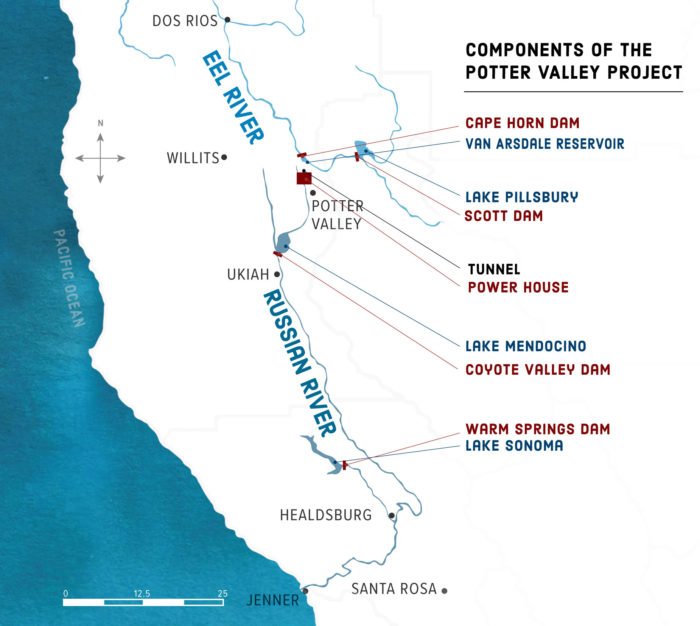OUR SHARED WATER
The Potter Valley Project
The Potter Valley Project is a collection of water infrastructure components, including two Eel River dams (Scott Dam and Cape Horn Dam), a powerhouse, and water diversion facilities.
The Project has generated clean hydropower and delivered water that is used by more than 650,000 people downstream of Potter Valley in Mendocino, Sonoma and Marin Counties. For about 100 years, PG&E held a license from the Federal Energy Regulatory Commission (FERC) to operate the facilities, but the company chose to let the license expire in 2022.
Now, the Project facilities will be decommissioned and removed, and the water supply that flowed into the Russian River for more than 100 years is in jeopardy.
New facilities must be installed to ensure that water continues to flow into the Russian River to support the environment and communities throughout Mendocino, Sonoma and Marin. The Eel-Russian Project Authority (ERPA) is the new authority that will have the legal capacity to own, construct and operate a new water diversion facility near the Cape Horn Dam. Moving forward, there will be a significant change in how water supplies are managed, and increased costs for water to fund construction and operation of the new infrastructure.

POTTER VALLEY PROJECT
Current Benefits
Without year-round water, downstream communities would face grave economic impacts.
Communities directly impacted:
- Potter Valley
- Redwood Valley
- Calpella
- Ukiah Valley
- Talmage
- Hopland
- Cloverdale
- Geyserville
- Healdsburg
Lake Mendocino contributes to drinking water supplies for more than 31,000 people in Redwood Valley, Calpella, Talmage, the Ukiah Valley, Hopland, Potter Valley, and more.
Farmers from Redwood Valley through Hopland who use water from Lake Mendocino annually generate or support:
- More than $743 million of the county’s $3.5 billion in revenue
- More than 5,000 of the 32,000 jobs
- Approximately $16.1 million in local tax revenue
Some of the water stored in Lake Mendocino is dedicated to fishery migration flows that are required at specific times of the year in the Russian River below Lake Mendocino.
Currently, the Potter Valley Powerhouse has the maximum capacity to generate 9.2 megawatts. Under the current operation, the powerhouse has the power-generating capacity to support about 2,000 homes, if a typical home uses 30 kWh/day.
Lake Pillsbury and Lake Mendocino support elk herds, many bird species, mammals such as bears and mountain lions, amphibians, reptiles, and so much more.
Winter rainfall and snow melt stored in Lake Pillsbury provide water for summer and fall recreation in Lake Pillsbury, parts of the Eel River, Lake Mendocino, and the Russian River from Coyote Valley Dam to Jenner.
Activities include camping, hiking, biking, fishing, boating, water-skiing, kayaking, canoeing, rafting, swimming, picnicking, and more.
Stored water and ag land have helped mitigate the effects of recent wildfires.
- Lake Pillsbury and Lake Mendocino
- Agricultural ponds
- Irrigated fields serve as fire breaks
The water collected from the dams year-round help feed ground water for local communities, such as the city of Ukiah.
Where We Go From Here
Changes Are Coming
PG&E will be decommissioning the Potter Valley Project and our region will need to determine a new way to continue water diversions and fund necessary infrastructure and operational changes.
Maintain Water Supply Reliability
Water supply reliability is possible, even as changes are made to improve environmental and habitat protections.
Moving Forward
IWPC will continue to work toward water supply solutions that are fair and equitable and maintain the ability to manage supplies through increasingly unpredictable weather conditions.









